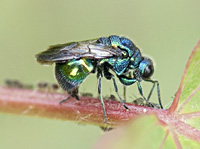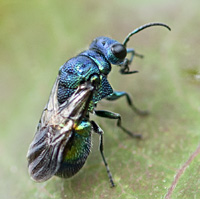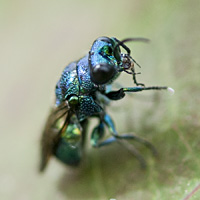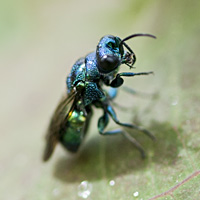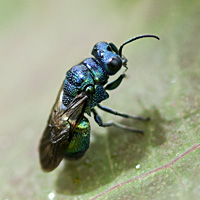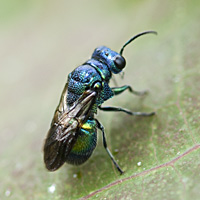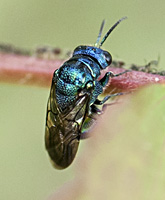[All pictures of garden wildlife on this page are thumbnails. Click on any thumbnail for a large format to be displayed.]

Pseudomalus violaceus
| Taxonomy | ||||||
|---|---|---|---|---|---|---|
| Kingdom: | Phylum: | Class: | Order: | Family: | Genus: | Species: |
| Animalia | Arthropoda | Insecta | Hymenoptera | Chrysididae | Pseudomalus | P. violaceus |
Pseudomalus violaceus belongs to the genus of cuckoo wasps (Psedomalus). In the past it was referred to as Omalus violaceus. This wasp is about 6-7mm in length with striking metallic blue-green coloration. It is on the wing from May till September. Pseudomalus violaceus is relatively common in Europe (including Scandinavia, The Netherlands, Belgium, Luxembourg, France, Spain, Germany, Italy, Poland and Hungary) and Asia (including Manchuria and Siberia). This wasp is rather scarce in Great Britain and Ireland.
This wasp kept on coming back to the same plant so it was relatively easy to photograph. I have noticed that the wasp was obviously attracted to aphids sitting on the plant. According to the Chrysis specialist, Paolo Rosa, the photos here show a female laying eggs on aphids. Some literature suggests that female of Pseudomalus violaceus lays eggs on aphids with an intention that a female of Pemphredon wasp (a Crabronid wasp) will capture an infected aphid and take it back to its nest. After hatching, the Pseudomalus violaceus larva kills the Pemphredon host and consumes the content of the nest.
Several species of Chrysididae resemble one another and it is very difficult to identify them exactly. This applies to Omalus aeneus, Pseudomalus violaceus and male Hedychrum chalybaeum. (Pseudo)malus and Hedychrum differ by slight vein pattern in the wings. Therefore it is not absolutely certain that the Chrysis sp. in the photos here is Pseudomalus violaceus. I base my identification not just on the outer features of the wasp but also on its behaviour. Since I have observed a repeated interaction of the wasp with aphids I assume it is Pseudomalus violaceus.

© Copyright 1998-2024 gardensafari.net (Hania Berdys)

 English / engels
English / engels  Dutch / nederlands
Dutch / nederlands